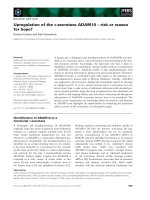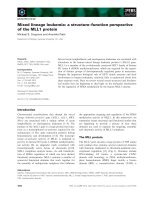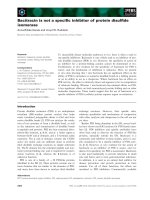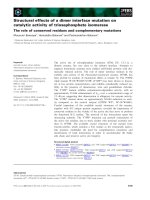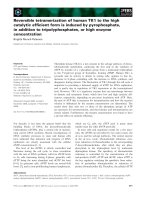Tài liệu Báo cáo khoa học: Pharmacologic chaperoning as a strategy to treat Gaucher disease ppt
Bạn đang xem bản rút gọn của tài liệu. Xem và tải ngay bản đầy đủ của tài liệu tại đây (482.12 KB, 7 trang )
MINIREVIEW
Pharmacologic chaperoning as a strategy to treat Gaucher
disease
Zhanqian Yu, Anu R. Sawkar and Jeffery W. Kelly
Department of Chemistry and The Skaggs Institute for Chemical Biology, The Scripps Research Institute, La Jolla, CA, USA
Introduction
Human lysosomal storage diseases are loss of function
disorders, typically caused by a deficient lysosomal gly-
colipid hydrolysis activity, leading to intralysosomal
accumulation of the enzymes substrate(s) [1,2].
Although each lysosomal storage disease has unique
characteristics, generally they are progressive in nature
and lead to an enlarged liver and spleen, bone and
skeletal changes, short stature and respiratory and ⁄ or
cardiac problems.
Gaucher disease (GD) is caused by deficient lyso-
somal glucocerebrosidase (GC or acid b-glucosidase)
activity [3,4]. Glucocerebrosidase degrades glucosylcer-
amide (Fig. 1) into glucose and ceramide, which are
recycled in the cytoplasm. Mutations in both alleles of
GC sometimes result in the accumulation of glucosyl-
ceramide in the lysosomes of monocyte-macrophage
cells, often leading to hepatomegaly, splenomegaly,
anemia and thrombocytopenia, bone lesions, and some-
times central nervous system (CNS) involvement [5,6].
Patients not exhibiting CNS symptoms are classified as
type 1, whereas the 4% of patients presenting with
CNS involvement are classified as either type 2 (acute
infantile) or type 3 (juvenile or early adult onset).
Of the 200 mutations associated with GD, only a
few are prominent. For example, over 70% of the vari-
ant alleles among the Ashkenazi Jewish subjects are
N370S (Fig. 2B) [5,7–9]. The neuropathic L444P allele
occurs at a much higher frequency (37.5%) among
non-Jewish subjects (Fig. 2B). GD is recessive, mean-
ing that patients require mutations in both GC alleles
to present with symptoms and, even then, the pene-
trance is variable, suggesting that physiological and
Keywords
endoplasmic reticulum-associated
degradation; folding; Gaucher disease;
neuropathic Gaucher disease; pharmacologic
chaperone; traficking; type 2 Gaucher
disease; type 3 Gaucher disease
Correspondence
J. W. Kelly, Department of Chemistry and
The Skaggs Institute for Chemical Biology,
The Scripps Research Institute, 10550 North
Torrey Pines Road, BCC265, La Jolla,
CA 92037, USA
Fax: +1 858 784 9610
Tel: +1 858 784 9880
E-mail:
(Received 8 June 2007, accepted 8 August
2007)
doi:10.1111/j.1742-4658.2007.06042.x
We briefly introduce the most common lysosomal storage disorder, Gau-
cher disease, concisely describe the Food and Drug Administration
approved strategies to ameliorate Gaucher disease, and then outline the
emerging pharmacologic chaperone strategy that offers the promise to
remedy this malady.
Abbreviations
CNS, central nervous system; ER, endoplasmic reticulum; ERAD, endoplasmic reticulum-associated degradation; ERT, enzyme replacement
therapy; GC, glucocerebrosidase; GD, Gaucher disease; WT, wild type.
4944 FEBS Journal 274 (2007) 4944–4950 ª 2007 The Authors Journal compilation ª 2007 FEBS
genetic background differences also influence disease
onset.
GD is currently treated by enzyme replacement ther-
apy (ERT) [10], wherein a recombinant GC enzyme is
administered intravenously. Identification of a man-
nose receptor on macrophages made it possible to spe-
cifically target this cell type by creating recombinant
‘mannose-terminated’ GC that is recognized by man-
nose receptor, endocytosed and delivered to the lyso-
some, where it partially restores GC activity. In spite
of the fact that lysosomal localization is very ineffi-
cient, ERT is currently the treatment of choice for
non-neuropathic GD. Unfortunately, GC replacement
therapy does not ameliorate the damage to the CNS
that exists in type II ⁄ III patients because the recombi-
nant enzyme used in ERT does not cross the blood–
brain barrier.
Another strategy for treating GD is substrate reduc-
tion therapy [11]. The premise behind this strategy is
that intralysosomal glucosylceramide accumulation will
occur in individuals where the amount of substrate
exceeds the capacity of the endogenous mutant GC
enzyme to degrade it. Because reducing glucosylcera-
mide influx will restore the balance between substrate
synthesis and degradation in the lysosome, inhibition of
glucosylceramide biosynthesis may improve the clinical
course of disease. ZavescaÒ (Actelion Pharmaceuticals,
South San Francisco, CA, USA) has recently been
approved in Europe and the USA for use in patients
with mild to moderate type 1 GD, for whom enzyme
replacement therapy is not a feasible option. Condi-
tional approval resulted because Gaucher patient
response was better with ERT [12]. Yet another possible
strategy to treat GD is gene therapy mediated by adeno-
and lentiviral vector delivery, although significant hur-
dles still exist with the implementation of gene therapy
as a practical and safe therapeutic strategy [13].
GD is generally caused by GC mutations that com-
promise folding inside the endoplasmic reticulum
(ER). Hence, clinically important variants such as
NHO
HO
OH
H
N
O
N
H
OH
HO
OH
Isofagomine
N-Adamantyl-4-((3R,4R,5R)-3,4-dihydroxy-
5-(hydroxymethyl)piperidin-1-yl)butanamide
N
HO
HO
HO
HO
NB-DNJ (Zavesca
®
)
O
HO
HO
OH
HO
O
OH
HN
O
(CH
2
)
16
CH
3
(CH
2
)
12
CH
3
Glucosylceramide
CH
3
HO
HO
OH
HO N
H
(CH
2
)
7
CH
3
N-Octyl-
β
-valienamine
N
HO
HO
HO
HO
n-Nonyl
NN-DNJ
Fig. 1. Chemical structures of glucosylcera-
mide, the substrate for glucocerebrosidase,
ZavescaÒ, the substrate reduction therapy
compound approved by the Food and Drug
Administration and selected glucocerebrosi-
dase pharmacologic chaperones.
AB
N370S
L444P
IVS2+1
84GG
recombination
Other
Ashkenazi Jewish
Patients
Non-Jewish
patients
76.6%
3.3%
2.5%
12.3%
<1%
4.9%
28.9%
37.5%
<1%
<1%
3.1%
28.9%
Fig. 2. (A) Ribbon diagram representation of the crystal structure of glucocerebrosidase depicting the location of the GD-associated point
mutations. (B) Frequency of GC point mutations in human GD patients.
Z. Yu et al. Strategies to ameliorate Gaucher disease
FEBS Journal 274 (2007) 4944–4950 ª 2007 The Authors Journal compilation ª 2007 FEBS 4945
N370S and L444P GC are largely degraded by endo-
plasmic reticulum-associated degradation (ERAD)
mediated by the proteasome, instead of being properly
folded in the ER and trafficked to the lysosome.
Because of extensive ERAD, there is little mutant GC
in the lysosome, and the fraction that does localize
properly only has fractional glucosylceramide hydro-
lase activity. That said, the fractional activity appears
to be sufficient to ameliorate disease, when folding and
trafficking efficiency is increased, resulting in an
increase in the mutant GC concentration in the lyso-
some.
Permissive growth temperatures (below 37 °C) often
enable enhanced folding and lysosomal trafficking of
GC variants in patient derived cells, providing hope
that one can restore proper cellular folding and traf-
ficking to these endogenous enzymes utilizing a small
molecule strategy [14]. Moreover, by growing cells at a
temperature that permits enhanced GC ER folding
and trafficking to the lysosome, the temperature can
then be increased to 37 °C revealing that these mutant
enzymes are stable and functional in the lysosomal
environment once folded. Biophysical studies using
cell-derived mutant GC proteins and recombinant
mutant GC proteins reveal that these enzymes often
exhibit substantially decreased stability at the neutral
pH condition found in the ER, yet these mutant
enzymes generally exhibit near wild type (WT) stability
at lysosomal pH (approximately pH 5).
That it is possible to correct the folding and traffick-
ing of mutant GCs in cells using a permissive growth
temperature motivated us, and subsequently others, to
explore whether ER permeable active-site-directed
inhibitors of GC could bind to and stabilize these
folded mutant enzymes in the ER, enabling their traf-
ficking on to the lysosome (Fig. 3). These so-called
‘pharmacologic chaperones’ are envisioned to assist the
macromolecular chaperones by binding to the small
fraction of mutant GC that does fold in the ER, stabi-
lizing that folded conformational ensemble and thereby
enabling coupling to the secretory apparati. Thus, by
LeChatlier’s principle, pharmacologic chaperones shift
the equilibrium towards folding at the expense of
ERAD, enabling folded GC to engage the exocytic
pathway that carries it to the lysosome. Once mutated
GC is localized to the lysosome, the glucosylceramide
substrate is able to displace the inhibitor and allow
the enzyme to turn over glucosylceramide, owing to
Fig. 3. Mechanism of pharmacologic chaper-
oning, adapted with permission from Saw-
kar et al. [5]. Pharmacologic chaperones
bind to the folded glucocerebrosidase (GC)
enzyme population in the ER, shifting the
equilibrium toward the folded conforma-
tional ensemble, away from the unfolded
ensemble that is subject to ERAD mediated
by the proteasome. Pharmacologic chaper-
oning of GC enables a greater proportion of
GC to be folded and thus engage the exo-
cytic pathway that trafficks it to through the
Golgi and on to the lysosome, increasing
the concentration of the folded enzyme hav-
ing partial wild-type activity in the lysosome.
Glucosylceramide displaces the pharmaco-
logic chaperone in the lysosome, enabling
the enzyme to cleave glucosylceramide into
glucose and ceramide. Pharmacologic chap-
eroning of GC increases the folding and traf-
ficking efficiency of GC, increasing its
concentration in the lysosome, restoring par-
tial function, and offering the possibility to
ameliorate GD.
Strategies to ameliorate Gaucher disease Z. Yu et al.
4946 FEBS Journal 274 (2007) 4944–4950 ª 2007 The Authors Journal compilation ª 2007 FEBS
the high lysosomal concentration of glucosylceramide.
Thus the cellular GC activity goes up because of an
increased lysosomal concentration, despite the fact
that the pharmacologic chaperone is actually a GC
inhibitor.
Unlike nonspecific, low molecular weight osmolytes,
such as glycerol, dimethyl sulfoxide and trimethyl-
amine N-oxide that have been shown to increase
proper folding and trafficking of variant proteins when
included in the cell culture medium at high (mm) con-
centrations [15], pharmacologic chaperones are typi-
cally effective at much lower concentrations (nm to
lm) and stabilize just one protein and thus are gener-
ally protein and disease selective, if not specific.
Many of the clinically important Fabry disease-asso-
ciated a-galactosidase A variants (causing another
lysosomal storage disease) were shown to be folding
and trafficking mutants [16] before this was explored
as a possibility in GD. Galactose administration
increased Q279E a-galactosidase A residual activity in
patient derived cells; thus, galactose was demonstrated
to be first active-site-directed pharmacologic chaperone
for a lysosomal storage disease. Galactose administra-
tion (1 gÆkg
)1
body weight) every other day proved
to be effective therapy for a Fabry disease patient
harboring the G328R variant, meaning that a heart
transplant was no longer required [17]. An active-site-
directed pharmacologic chaperone for a-galactosi-
dase A discovered by Jian-Qiang Fan and developed
by Amicus Therapeutics is currently in Phase II clinical
trials for Fabry disease [18,19]. A thorough review of
a-galactosidase A pharmacologic chaperones for Fabry
disease is provided in an accompanying minireview by
Fan & Ishii [20].
The GD-associated N370S, G202R and L444P GC
mutations reduce lysosomal GC concentration by
impairing proper folding and trafficking, apparently by
similar, but not identical mechanisms. These GC vari-
ants exhibit distinct subcellular localization patterns in
patient-derived fibroblasts: N370S GC exhibits weak
lysosomal localization, G202R GC is retained in the
ER, and L444P is largely degraded with a small frac-
tion making it to the lysosome [14,21]. The N370S,
L444P and G202R GC mutations reduce the stability
of GC in the ER as an apparent consequence of the
neutral pH environment there, resulting in enough
ERAD to reduce lysosomal GC concentration and
activity [14]. The folding and trafficking of G202R and
L444P GC is temperature-sensitive, providing further
evidence that these variants are deficient in folding and
are recognized by ERAD [14,21].
Several GC variants have been shown to be amena-
ble to pharmacologic chaperoning in patient-derived
cell lines [14,22–30]. Moreover, several distinct struc-
tural classes of GC pharmacologic chaperones have
been discovered [14,22–30]. In 2002, we demonstrated
that the active-site-directed GC inhibitor N-(n-nonyl)
deoxynorjirimycin acted as pharmacologic chaperone
for N370S, but not L444P GC in patient-derived fibro-
blasts [22], stabilizing GC against thermal denaturation
and increasing cellular N370S GC activity two-fold by
increasing ER folding efficiency and lysosomal traffick-
ing. Several other nitrogen-containing heterocycles and
monosaacharides that also inhibit enzymes that make
and break glucosyl bonds were also shown to be N370S
GC pharmacologic chaperones, including morpholine
and piperazine-based molecules. N-(n-butyl)deoxynorj-
irimycin (ZavescaÒ), does not act as a pharmacologic
chaperone under comparable conditions in these cell
lines [22,25,26]. In 2004, Lin and colleagues reported
that application of N-octyl-b-valienamine (Fig. 1)
increased the cellular activity of F213I GC six-fold;
however, this compound proved to be ineffective in the
N370S and L444P cell lines tested [23]. In 2005, we
reported that terminating the DNJ N-alkyl chain with
an adamantyl group results in very active N370S and
G202R GC pharmacologic chaperones [25]. N-octyl-
isofagomine and N-octyl-2,5-dideoxy-2,5-imino-d-gluci-
tol were also reported to be pharmacologic chaperones,
enhancing cellular N370S and G202R GC activity [25].
Collectively, the data demonstrate that distinct GC
mutations exhibit different pharmacologic chaperoning
profiles in patient-derived cell lines. In 2005, Pocovi
and colleagues reported that increased N370S activity
was observed with 10 lm ZavescaÒ in transfected
COS-7 cells, in contrast to our observations in patient-
derived cell lines [22,24]. In 2006, Asano and colleagues
reported that a-1-C-nonyl-1,5-dideoxy-1,5-imino-d-xyli-
tol was more selective, but less potent as a pharmaco-
logic chaperone than N-(n-nonyl)deoxynorjirimycin
[27,29]. In 2006, Fan and colleagues reported that the
hydrophilic amino sugar isofagomine (Fig. 1) is a
potent inhibitor of GC and serves as a GC pharmaco-
logic chaperone that increased cellular N370S GC
activity two-fold by enhancing its cellular folding and
trafficking [26]. Kornfield and colleagues reported a
very similar result with isofagomine, just a few months
later [28]. Isofagomine is now being evaluated in a
phase II clinical study for GD by Amicus Therapeutics.
In 2007, we reported additional adamantyl terminated
N-alkyl isofagomines and 2,5-anhydro-2,5-imino-d-glu-
citol derativatives that are potent GC pharmacologic
chaperones [30]. More than a seven-fold enhancement
of cellular G202R GC activity was observed when cells
were cultured with N-a damantyl-4-((3R,4R,5R)-3,4-dihydr-
oxy-5-(hydroxymethyl)piperidin-1-yl)-butanamide (Fig. 1)
Z. Yu et al. Strategies to ameliorate Gaucher disease
FEBS Journal 274 (2007) 4944–4950 ª 2007 The Authors Journal compilation ª 2007 FEBS 4947
for 5 days (cellular N370S GC is increased by more
than 2.5-fold). These structure–activity relationships
are now easily rationalized by the 2007 GC structure of
Petsko and coworkers, revealing two hydrophobic
binding clefts proximal to the active site where the
monosaacharide substructure binds [31]. Collectively,
these data demonstrate that pharmacologic chaperon-
ing increases mutant GC folding efficiency in the
ER enhancing lysosomal trafficking, which increases
the lysosomal concentration of partially active GC vari-
ants, as demonstrated by increased cellular GC activity,
an increased concentration of lysosomal GC glyco-
forms and increased colocalization of GC with the lyso-
somal markers based on fluorescence microscopy
analysis.
All of the GC variants that are amenable to phar-
macologic chaperoning harbor mutations in the active-
site domain, whereas the L444P mutation, located in
the immunoglobulin-like domain of GC [31,32], does
not respond to pharmacologic chaperoning in patient-
derived cells when treated identically. Mutations in
domains remote from the chemical chaperone binding
active-site domain may continue to be subject to mis-
folding, despite binding-induced stabilization of the
active-site domain, especially if the domains are not
thermodynamically coupled. In the future, it may be
possible to discover a small molecule that binds to and
stabilizes the immunoglobulin-like domain, which
should correct the folding defect associated with the
L444P GC variant. Alternatively, it may be that the
L444P GC is actually being partially pharmacologi-
cally chaperoned and is more sensitive to inhibition
than the other variants because of its lower lysosomal
concentration, in which case new dosing and washout
regimens may be useful in restoring partial L444P GC
activity.
Lastly, in contrast to ERT and like substrate reduc-
tion therapy, a pharmacologic chaperone strategy for
GD relies on the endogenous activity of the folded
mutant GC enzyme. Thus, the pharmacologic chaper-
oning approach will not be able to increase cellular
GC activity in the case of mutations that do not pro-
duce a foldable protein or produce a folded product
lacking GC activity. In addition, enzymes that are
unable to bind the pharmacologic chaperone will not
benefit from this approach.
The promise of the pharmacologic
chaperone strategy for GD
Pharmacologic chaperones penetrate the plasma mem-
brane and the ER, and by binding to the folded mutant
GC enzyme population in the ER, shift the equilibrium
towards folding allowing mutant GC to be trafficked to
the Golgi and on to the lysosome more efficiently,
where the high substrate concentration and low pH
environment stabilize the GC fold enabling it to
degrade glucosylceramide. The resulting increase in
mutant lysosomal GC concentration and cellular activ-
ity is thought to be sufficient to ameliorate GD, a
hypothesis being tested by an ongoing GD clinical trial
utilizing the pharmacologic chaperone isofagomine.
Orally available pharmacologic chaperones that cross
the blood–brain barrier efficiently have the potential to
be useful for treating patients with type II and III GD,
for which there are currently no therapeutic options
available. In the future, it is likely that pharmacologic
chaperones will be used in concert with ERT to amelio-
rate lysosomal storage diseases, including GD.
Acknowledgements
The authors are grateful to Professor Evan Powers for
drawing Fig. 3, and to the National Institutes of
Health (DK075295), the National Gaucher Founda-
tion, Gaucher Disease Divot Classic (Grant no. 70),
the Skaggs Institute of Chemical Biology and the Lita
Annenberg Hazen Foundation for financial support of
the studies outlined herein.
References
1 Futerman AH & van Meer G (2004) The cell biology of
lysosomal storage disorders. Nat Rev Mol Cell Biol 5,
554–565.
2 Ginzburg L, Kacher Y & Futerman AH (2004) The
pathogenesis of glycosphingolipid storage disorders.
Semin Cell Dev Biol 15, 417–431.
3 Beutler E & Grabowski GA (2001) Gaucher disease. In
The Metabolic and Molecular Bases of Inherited Diseases
(Scriver CR, Beaudet AL, Sly WS, Valle D, eds), pp.
3635–3668. McGraw-Hill, New York, NY.
4 Brady RO, Kanfer JN, Bradley RM & Shapiro D
(1966) Demonstration of a deficiency of glucocerebro-
side-cleaving enzyme in Gauchers disease. J Clin Invest
45, 1112–&.
5 Sawkar AR, D’Haeze W & Kelly JW (2006) Therapeu-
tic strategies to ameliorate lysosomal storage disorders
) a focus on Gaucher disease. Cell Mol Life Sci 63,
1179–1192.
6 Zhao H & Grabowski GA (2002) Gaucher disease:
perspectives on a prototype lysosomal disease. Cell
Mol Life Sci 59, 694–707.
7 Grabowski GA (1997) Gaucher disease: gene frequencies
and genotype ⁄ phenotype correlations. Genet Test 1, 5–12.
8 Horowitz M, Pasmanik-Chor M, Borochowitz Z, Falik-
Zaccai T, Heldmann K, Carmi R, Parvari R, Beit-Or
Strategies to ameliorate Gaucher disease Z. Yu et al.
4948 FEBS Journal 274 (2007) 4944–4950 ª 2007 The Authors Journal compilation ª 2007 FEBS
H, Goldman B, Peleg L et al. (1998) Prevalence of
glucocerebrosidase mutations in the Israeli Ashkenazi
Jewish population. Hum Mutat 12, 240–244.
9 Stenson PD, Ball EV, Mort M, Phillips AD, Shiel JA,
Thomas NS, Abeysinghe S, Krawczak M, Cooper DN
(2003) Human gene mutation database (HGMD (R)):
2003 update. Hum Mutat 21, 577–581.
10 Weinreb NJ, Charrow J, Andersson HC, Kaplan P,
Kolodny EH, Mistry P, Pastores G, Rosenbloom BE,
Scott CR, Wappner RS et al. (2002) Effectiveness of
enzyme replacement therapy in 1028 patients with
type 1 Gaucher disease after 2–5 years of treatment:
a report from the Gaucher Registry. Am J Med 113,
112–119.
11 Cox TM, Aerts JM, Andria G, Beck M, Belmatoug
N, Bembi B, Chertkoff R, Vom Dahl S, Elstein D,
Erikson A et al. (2003) The role of the iminosugar
N-butyldeoxynojirimycin (miglustat) in the
management of type I (non-neuronopathic) Gaucher
disease: a position statement. J Inherit Metab Dis 26,
513–526.
12 Elstein D, Hollak C, Aerts JM, van Weely S, Maas M,
Cox TM, Lachmann RH, Hrebicek M, Platt FM, But-
ters TD et al. (2004) Sustained therapeutic effects of
oral miglustat (Zavesca, N-butyldeoxynojirimycin, OGT
918) in type I Gaucher disease. J Inherit Metab Dis 27,
757–766.
13 Cabrera-Salazar MA, Novelli E & Barranger JA (2002)
Gene therapy for the lysosomal storage disorders. Curr
Opin Mol Ther 4, 349–358.
14 Sawkar AR, Schmitz M, Zimmer KP, Reczek D,
Edmunds T, Balch WE & Kelly JW (2006) Chemical
chaperones and permissive temperatures atter the
cellular locatization of Gaucher disease associated
glucocerebrosidase variants. ACS Chem Biol 1, 235–
251.
15 Brown CR, HongBrown LQ & Welch WJ (1997)
Correcting temperature-sensitive protein folding defects.
J Clin Invest 99, 1432–1444.
16 Ishii S, Kase R, Sakuraba H & Suzuki Y (1993)
Characterization of a mutant alpha-galactosidase
gene-product for the late-onset cardiac form of Fabry
disease. Biochem Biophys Res Commun 197, 1585–
1589.
17 Frustaci A, Chimenti C, Ricci R, Natale L, Russo MA,
Pieroni M, Eng CM & Desnick RJ (2001) Brief report:
improvement in cardiac function in the cardiac variant
of Fabry’s disease with galactose-infusion therapy. N
Engl J Med 345, 25–32.
18 Asano N, Ishii S, Kizu H, Ikeda K, Yasuda K, Kato A,
Martin OR & Fan J-Q (2000) In vitro inhibition and
intracellular enhancement of lysosomal a-galactosidase
A activity in Fabry lymphoblasts by 1-deoxygalactono-
jirimycin and its derivatives. Eur J Biochem 267, 4179–
4186.
19 Fan JQ, Ishii S, Asano N & Suzuki Y (1999) Acceler-
ated transport and maturation of lysosomal alpha-galac-
tosidase A in Fabry lymphoblasts by an enzyme
inhibitor. Nat Med 5, 112–115.
20 Fan J-Q & Ishii S (2007) Active-site-specific chaperone
therapy for Fabry disease. Yin and Yang of enzyme
inhibitors. FEBS J 274, 4962–4971.
21 Zimmer KP, Le Coutre P, Aerts H, Harzer K, Fukuda
M, O’Brien JS & Naim HY (1999) Intracellular trans-
port of acid beta-glucosidase and lysosome-associated
membrane proteins is affected in Gaucher’s disease
(G202R mutation). J Pathol 188, 407–414.
22 Sawkar AR, Cheng WC, Beutler E, Wong CH, Balch
WE & Kelly JW (2002) Chemical chaperones increase
the cellular activity of N370S beta-glucosidase: a thera-
peutic strategy for Gaucher disease. Proc Natl Acad Sci
USA 99
, 15428–15433.
23 Lin H, Sugimoto Y, Ohsaki Y, Ninomiya H, Oka A,
Taniguchi M, Ida H, Eto Y, Ogawa S, Matsuzaki Y
et al. (2004) N-Octyl-[beta]-valienamine up-regulates
activity of F213I mutant [beta]-glucosidase in
cultured cells: a potential chemical chaperone therapy
for Gaucher disease. Biochim Biophys Acta 1689, 219–
228.
24 Alfonso P, Pampin S, Estrada J, Rodriguez-Rey JC,
Giraldo P, Sancho J & Pocovi M (2005) Miglustat (NB-
DNJ) works as a chaperone for mutated acid beta-glu-
cosidase in cells transfected with several Gaucher disease
mutations. Blood Cells Mol Dis 35, 268–276.
25 Sawkar AR, Adamski-Werner SL, Cheng WC, Wong
CH, Beutler E, Zimmer KP & Kelly JW (2005) Gaucher
disease-associated glucocerebrosidases show mutation-
dependent chemical chaperoning profiles. Chem Biol 12,
1235–1244.
26 Chang HH, Asano N, Ishii S, Ichikawa Y & Fan JQ
(2006) Hydrophilic iminosugar active-site-specific chap-
erones increase residual glucocerebrosidase activity in
fibroblasts from Gaucher patients. FEBS J 273, 4082–
4092.
27 Compain P, Martin OR, Boucheron C & Godin G, Yu
L, Ikeda K & Asano N (2006) Design and synthesis of
highly potent and selective pharmacological chaperones
for the treatment of Gaucher’s disease. Chembiochem 7,
1356–1359.
28 Steet RA, Chung S, Wustman B, Powe A, Do H &
Kornfeld SA (2006) The iminosugar isofagomine
increases the activity of N370S mutant acid beta-gluco-
sidase in Gaucher fibroblasts by several mechanisms.
Proc Natl Acad Sci USA 103, 13813–13818.
29 Yu L, Ikeda K, Kato A, Adachi I, Godin G, Compain
P, Martin O & Asano N (2006) alpha-1-C-octyl-1-de-
oxynojirimycin as a pharmacological chaperone for
Gaucher disease. Bioorganic Med Chem 14, 7736–7744.
30 Yu ZQ, Sawkar AR, Whalen LJ, Wong CH & Kelly
JW (2007) Isofagomine- and 2,5-anhydro-2,5-imino-D-
Z. Yu et al. Strategies to ameliorate Gaucher disease
FEBS Journal 274 (2007) 4944–4950 ª 2007 The Authors Journal compilation ª 2007 FEBS 4949
glucitol-based glucocerebrosidase pharmacological chap-
erones for Gaucher disease intervention. J Med Chem
50, 94–100.
31 Lieberman RL, Wustman BA, Huertas P, Powe AC Jr,
Pine CW, Khanna R, Schlossmacher MG, Ringe D,
Petsko GA (2007) Structure of acid beta-glucosidase
with pharmacological chaperone provides insight into
Gaucher disease. Nat Chem Biol 3, 101–107.
32 Dvir H, Harel M, McCarthy AA, Toker L, Silman I,
Futerman AH & Sussman JL (2003) X-ray structure of
human acid-beta-glucosidase, the defective enzyme in
Gaucher disease. EMBO Rep 4, 704–709.
Strategies to ameliorate Gaucher disease Z. Yu et al.
4950 FEBS Journal 274 (2007) 4944–4950 ª 2007 The Authors Journal compilation ª 2007 FEBS
